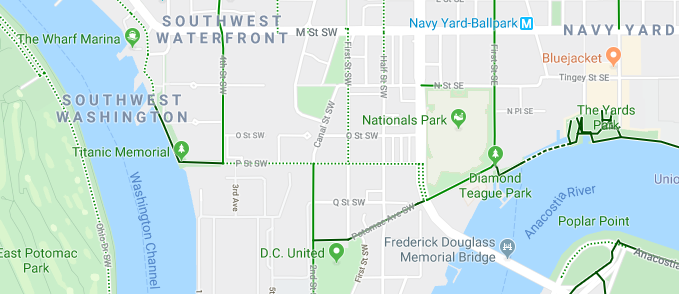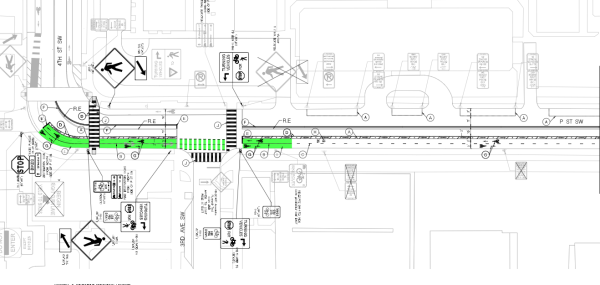A connected bikeway network wins out over parking protection on P Street SW

The 2nd Street segment of the Anacostia Riverwalk Trail, adjacent to the new portion. Image by Stephen Hudson.
Despite opposition from the local Advisory Neighborhood Commission, DC will build a protected bikeway on P Street SW, completing a missing link in the Anacostia Riverwalk Trail.
In a formal reply to the ANC (scroll to the bottom), District Department of Transportation (DDOT) Associate Director Jim Sebastian said the agency carefully considered objections from ANC 6D and concludes that moving forward is the best option.
In the September notice to the ANC, transportation planner Will Handsfield said the project will create “a clear walking, biking, scootering route for people traveling in and through Southwest DC, and especially linking the two stadia, the Wharf, the Southwest Waterfront Metro, and Navy Yard areas.” It will serve users “between 8 and 80 years old,” reduce car trips, and make the road safer for people on foot, bike, or scooter.
To the northwest, there are currently bike lanes on 4th Street SW and a path through the park by the Titanic Memorial. To the east, there’s a protected bikeway on 2nd Street SE. But this two-block stretch of P is a gap. It’s not possible to stay along the shoreline because Fort McNair controls everything south of P.
Bicycle facilities in the area by Google Maps.
One of the most significant statements in the DDOT response reminds the ANC that this segment has long appeared in multiple plans over the years:
This trail segment is one of the most significant gaps in the existing trail network, and has been identified as the proposed route of the ART since the Anacostia Framework Plan was released in 2003, and has been in every document related to the construction of the ART since that time, including MoveDC and the 2018 National Capital Trails plan released by a coalition of inter-jurisdictional groups, and including DDOT and NPS.
It’s a constant challenge that DC can create a plan for a citywide transportation network, or a trail along the entire river, but then face individual neighborhood opposition to implementing that plan years later as it moves forward. Transportation spans neighborhoods and the city needs the ability to plan at that higher level. Certainly residents can raise issues and ask for officials to consider them, but in this case, DDOT did thoroughly study the ANC’s suggestions for alternatives and found them impractical.
For instance, the ANC asked about putting the lane between the sidewalk and the Ft. McNair wall, but besides having “poor sightlines” and more risk of collisions, Sebastian said it could kill the oak trees along the street and would not be wide enough in any case.
Plans for the bikeway by DDOT.
The ANC had argued residents need the 26 parking spaces that are currently along this segment of P Street, adjacent to Fort McNair, since, it said, residents don’t have enough alternatives to driving. As WashCycle explained and Sebastian says in his letter, DDOT’s policy has been to only put residentially-zoned parking on the sides of streets with residents, in any case, which doesn’t apply to the south side of P. Further, many of the buildings in this area already have their own parking lots.
Sebatian wrote, “the agency’s role in managing and regulating public space is to ensure safety and access for all travelers, not simply to provide private vehicle storage for nearby residents.” With this step, it seems to be standing up for these principles.
Correction: The initial version of this article said the reply to the ANC came from Will Handsfield. Handsfield had been the author of the original September notice but the reply was from Jim Sebastian. The article has been corrected, along with some additional citations to Sebastian’s letter.

